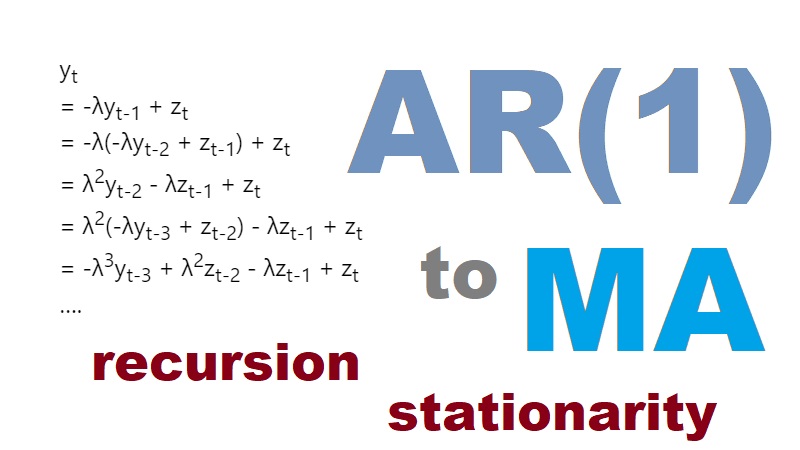In this post, we’ll learn to convert a AR(1) model to a MA model.
The moving-average model specifies that the output variable depends linearly on the current and various past values of a stochastic (imperfectly predictable) term.
https://en.wikipedia.org/wiki/Moving-average_model
So, a MA model should only depend on zt-k, where k >= 0.
Converting a AR(1) Model to a MA model
Rt – μ = -λ(Rt-1 – μ) + σ*zt —————– (1)
Let
yt = (Rt – μ)/σ
Dividing (1) by σ,
(Rt – μ)/σ = -λ(Rt-1 – μ)/σ + zt
yt = -λyt-1 + zt
Similarly,
yt-1 = -λyt-2 + zt-1
yt-2 = -λyt-3 + zt-2
etc
Therefore,
yt
= -λyt-1 + zt
= -λ(-λyt-2 + zt-1) + zt
= λ2yt-2 – λzt-1 + zt
= λ2(-λyt-3 + zt-2) – λzt-1 + zt
= -λ3yt-3 + λ2zt-2 – λzt-1 + zt
….
Since λ is the multiplier for Rt−1, it should be smaller than one as the effect of Rt−1 dies off over time.
Therefore, as we keep replacing yt-k, the y-term eventually gets multiplied by a very small value of λk and becomes insignificant.
Therefore,
yt = sum of (-λ)kzt-k for k from 0 to infinity
Since
yt = (Rt – μ)/σ
Rt = σyt + μ
Since yt only depends on values of zt-k, Rt only depends on zt-k too, where k>=0.
In other words, Rt only depends on current and past values of z. We have successfully converted it to a MA model.
Useful conclusion:
E[zsyt] = 0 for t < s
This means zs and yt are independent. Put it another way, yt does not depend on zs, where s is a future time compared to t. Therefore,
E[zt(Rt-1 – μ)] = 0
which is an intuitive property that we stated when solving the AR(1) model previously.


Leave a Reply